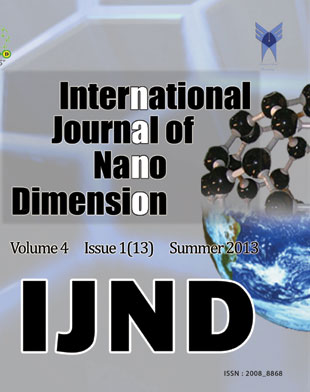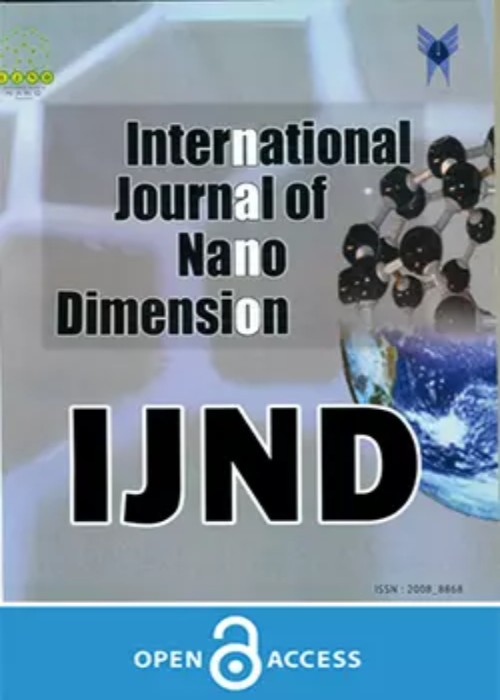فهرست مطالب

International Journal of Nano Dimension
Volume:4 Issue: 1, Summer 2013
- تاریخ انتشار: 1392/01/17
- تعداد عناوین: 11
-
Pages 1-6Magnesium oxide nanotubes of finite length are investigated by the Density Functional Theory (DFT) at the B3LYP/6-31G (d) level. The (6, 0) zigzag and (4, 4) armchair of MgO nanotubes were considered and nuclear magnetic resonance properties including isotropic and anisotropic chemical shielding parameters (CSI and CSA) were calculated for 25Mg and 17O atoms of the optimized structures for the first time. The calculated CS parameters indicated that the Mg atoms cause slight changes of electronic environment in the MgONT structures, but the changes for the O atoms are more significant. Results indicated that the zigzag MgONTs could be considered a more reactive material than the armchair model for interactions with other atoms or molecules.Keywords: Density Functional Theory (DFT), Magnesium Oxide nanotubes, Chemical shielding, Nuclear Magnetic Resonance(NMR)
-
Anatase TiO2 and mixed M-Anatase TiO2 (M = CeO2 or ZrO2) Nano powder: Synthesis and characterizationPages 7-12Pure Anatase Titania (TiO2), mixed 1.0 wt.% Cerium-Anatase Titania (1.0 wt.%CeO2-TiO2), and mixed 1.0 wt.% Zirconia-Anatase Titania (1.0 wt.%ZrO2-TiO2) nano powders were synthesized by co-precipitation method and characterized using X-ray diffraction (XRD), Brunauer-Emmett-Teller (BET) surface area analysis, UV-Vis diffuse reflectance spectroscopy (DRS), and transmission electron microscope (TEM) technique. The characterization results indicated that the crystal powders of the synthesized TiO2-based material were estimated nanometer in size and predominantly in the form of anatase with good crystalline nature. The grain sizes of the powders were observed in the range of 7.65 – 12.56 nm. The presence of the CeO2 and ZrO2 in TiO2 matrix has shifted the adsorption edge to higher wavelength region (red shift) in addition to increase the BET specific surface area. This study indicated that the CeO2 and ZrO2 demonstrated a beneficial effect on the structural and optical properties of TiO2.Keywords: Anatase, Titania, Ceria, Zirconia, Co, precipitation, Nano powder
-
Pages 13-20A simple and rapid microextraction procedure based on the application of magnetic nanoparticles and hydrophobic 1-Hexylpyridinium hexafluorophosphate [Hpy][PF6] ionic liquid (IL) was applied to trace determination of gatifloxacin. A mixture of [Hpy][PF6] and magnetic nanoparticles was injected into the sample solution containing the analyse of interest and a cloudy solution was formed. After centrifuging, the sediment phase containing enriched analyse was determined by spectrofluorimetry. Magnetic nanoparticles used in this microextraction procedure significantly improved the extraction recovery which is due to its proper hydrophobicity. [Hpy][PF6] was used as the extraction solvent due to some physicochemical properties such as high hydrophobicity, water immiscibility and quite viscosity. Under optimum experimental conditions, the proposed method provided a limit of detection (LOD) of 0.09 μg L-1 and a relative standard deviation (R.S.D.) of 3.0%. The present technique was applied to gatifloxacin determination in pharmaceutical formulations and human urine.Keywords: Ionic liquid, Microextraction, Magnetic nanoparticles, Gatifloxacin, Spectrofluorimeter, Pharmaceutical
-
Pages 21-27CdSe nanostructures were synthesized by using green chemical route as starch was used as capping agent. XRD, HR-TEM, SEAD, UV and PL studies were made for structural and optical properties of the prepared sample. Film morphology and the thickness measurement of n-CdSe were carried out with AFM analysis. I-V characteristics curve of this junction confirmed the formation of Schottky contact between silver (Ag) and CdSe nanostructures. Intrinsic and contact behaviors such as saturation current, barrier height, effective Richardson constant, electron affinity and ideality factor were calculated from the current-voltage characterization.Keywords: Green synthesis, CdSe nanostructure, Schottky cell, Optoelectronic characterization, Energy Band Diagram
-
Pages 29-49This paper presents the thermal vibration analysis of double-layer graphene sheet embedded in polymer elastic medium, using the plate theory and nonlocal continuum mechanics for small scale effects. The graphene is modeled based on continuum plate theory and the axial stress caused by the thermal effects is also considered. Nonlocal governing equations of motion for this double-layer graphene sheet system are derived from the principle of virtual displacements. The closed form solution for thermal-vibration frequencies of a simply supported rectangular nanoplate has been obtained by using the Navier’s method of solution. Numerical results obtained by the present theory are compared with available solutions in the literature and the molecular dynamics results. The influences of the small scale coefficient, the room or low temperature, the high temperature, the half wave number and the aspect ratio of nanoplate on the natural frequencies are considered and discussed in detail. The thermal vibration analysis of single- and double-layer graphene sheets are considered for the analysis. The mode shapes of the respective graphene system are also captured in this work. The present analysis results can be used for the design of the next generation of nanodevices that make use of the thermal vibration properties of the double-layer graphene system.Keywords: Graphene, Thermal vibration, Nonlocal Elasticity Theory, Small scale, Mode shape
-
Pages 51-56SiO2-coated Cobalt Ferrite (CoFe2O4) nanoparticles were obtained by the hydrolysis of tetraethylorthosilicate in the presence of CoFe2O4 nanoparticles in co-precipitation. The effects of SiO2coating on the magnetic properties of CoFe2O4 nanoparticles were investigated. The structural, morphological and magnetic properties of as-prepared sample were characterization by X-ray diffraction (XRD), Fourier transform infrared (FT-IR) spectra, transmission electron microscopy (TEM), Field emission scanning electron microscopy/energy dispersive x-ray analysis (FESEM-EDAX) and magnetic measurements were investigated using vibrating sample magnetometer (VSM). The morphology analysis confirmed that the obtained composite nanoparticles consisted of CoFe2O4 coated by SiO2. It was shown that the saturation magnetization and coercivity of CoFe2O4 decreased after SiO2 coating, which can be interpreted by the interparticle dipole-dipole interactions related to the magnetic particle volume fraction in the composite nanoparticles.Keywords: Synthesis, Magnetic properties, SiO2, coated cobalt ferrite, Nanoparticles, X-ray diffraction (XRD), Energy dispersive
-
Pages 57-62Graphite oxide constitutes carbon network with oxygen atoms both on hexagonal arrangement and the edge sites. Structural and electronic properties for graphite-oxygen complexes have been explored using first-principles total-energy calculations within the local density approximation (LDA). Band structures and density of states for the propose carbon 3D models are reported. A finite energy gap and planarity of graphene layer emerges for the oxygen-functionalized graphite, therefore its value varies with the ratio of carbon to oxygen and sites on carbon network.Keywords: Graphite oxides, Band structure, Density of states, Local Density Approximation, First, principles
-
Pages 63-68Nano-zeolite CoAPO-5 as a member of AFI family, was synthesized via a hydrothermal treatment, and structurally characterized using X-ray diffraction (XRD), scanning electron microscope (SEM), and energy dispersive X-ray analysis (EDAX). The effects of crystallization temperature and time on the structure of these powder products were studied. XRD patterns of the synthesized powders revealed a high-crystallinity and pure phase of AFI. SEM images and Scherrer equation showed the nano-size of the obtained CoAPO-5. Also, SEM images showed nano-wires as small as 30-50 nm in CoAPO-5 structures. According to EDAX analysis, P/Al ratio of the prepared CoAPO-5 powder was about 1.5. Crystal sizes and the crystallinity of CoAPO-5 reduced at higher temperatures of hydrothermal treatment. On the other hand, the larger crystals grew by increasing the crystallization time from 24 to 48 h.Keywords: Nano, Zeolite, CoAPO, 5, Synthesis, Characterization, Structure, Temperature
-
Pages 69-76A new signal amplification strategy based on simultaneous application of gold nanoparticles (AuNPs) and horseradish peroxidase (HRP) was employed to improve the sensitivity of an electrochemical immunoassay for detection of human IgG (hIgG), as a model antigenic protein. This immunoassay system was fabricated on magnetic carboxyl-functionalized multi-walled carbon nanotubes (COOH-MWCNT/Fe3O4 nanocomposite). The COOH-MWCNT/Fe3O4 nanocomposite was constructed by chemical co-precipitation of Fe2+ and Fe3+ in alkaline solution in the presence of the COOH-MWCNT. Goat anti-human IgG (anti-hIgG) was covalently bound to the carbon nanotubes and the resulting anti-hIgG bearing nanocomposite was immobilized on the surface of a gold electrode using a permanent magnet. Human IgG (hIgG) as an antigen was detected electrochemically using a secondary HRP-conjugated anti-hIgG immobilized noncovalently on the surface of AuNPs. Electrochemical detection of hIgG was performed in the presence of H2O2 and KI as substrates of HRP. When the concentration of antigen was 200 ng/ml, the sandwich arrangement with AuNPs amplified electrochemical response 56 μA more than a same sandwich arrangement without AuNPs. Binding of HRP-conjugated anti-hIgG to AuNPs was studied by UV–Visible and fluorescence spectrophotometry. The spectrophotometric data showed that binding of antibody molecules to AuNPs occurred without any significant structural changes.Keywords: Signal amplification, Gold nanoparticles, Electrochemical immunoassay, Human IgG, COOH, MWCNT, Fe3O4 nanocomposite
-
Pages 77-83The development of the eco friendly procedures makes nanoparticles as the rapidly growing field of nanotechnology. Amongst, the silver nanoparticles have become prominent in the field of medicine to their peculiar antimicrobial properties. In the present study we suggest an eco friendly procedure of extracellular synthesis of silver nanoparticles with an average sizes of 5-50nm using an Actinomycete isolated from mangrove soil. The silver nanoparticles were characterized with UV-Visible spectrophotometer, FTIR and TEM analysis. The synthesized silver nanoparticles showed an excellent antibacterial property on multidrug resistance gram positive and gram negative bacterial strains.Keywords: Actinomycetes spp, Silver nanoparticles, Characterization, Antibacterial activity, Extracellular synthesis, TEM
-
Pages 85-89The transformation of biochemical information into a physical or chemical signal is the basic idea behind a biosensor. The efficient detection of charged biomolecules by biosensor with appropriate device has caught tremendous research interest in the present decade. The present work is related to the simulation study of the performance of a functionalized surface of a biologically sensitive field-effect transistor. The detection process is less time consuming and less expensive as it combines a biological sensor and a measurement circuit in a small chip. In this model, a constant potential difference is maintained in between the two electrodes, one of which is functionalized with different types of biomolecules. With the number of double strand DNA oligomers, the concentration of Na+ and Cl- ions in the electrolyte in between the electrodes is changed, resulting in changes in surface charge density and dipole moment. Monte-Carlo simulation is performed in a neutral environment after functionalizing one electrode by double strand DNA.Keywords: BioFET, Monte, Carlo simulation, Chemical potential, Dipole moment, Ionic concentration, Biosensor


